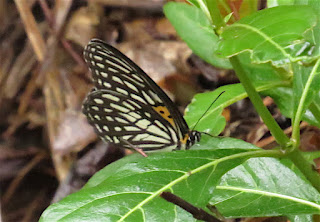When I
returned to Kathmandu from Chitwan, I knew that I was close to seeing my 5000th
lifebird; my first estimate was that I was about 30 birds away, but I also knew
that there were likely some errors in my lifelist spreadsheet, ones I had forgotten to
add during recent tours and trips, and various splits I hadn’t noticed. So in
the next few days I carefully compared my spreadsheet and everything I had in
eBird, and I had to do some research on photos and sound recordings of birds I
had made in Africa over four years ago and hadn’t quite caught up on. I also found some errors of omission from my Australia trip 7 1/2 years ago. It turns
out my lifelist stood at 4995 after Chitwan. Add two lifers right in Mich’s
yard (migrant Golden-spectacled Warber and Amur Falcon) in the following week
and a half, we were both pretty certain that a morning of birding in
Shivapuri-Nagarjun National on the outskirts of Kathmandu would put me over the
edge.
For the
second annual World Big Day of Birding on May 14, Mich and I were joined by Rajendra
Sawal, who works for the WWF and whom Mich met through his contacts at the US
embassy. One of Rajendra's claims to fame is having guided Jimmy Carter on birding trips in Nepal, in fact right along this road.
We weren’t doing a real big day, which is a 24-hour race to see as
many birds as possible; we were using this half day of birding as an excuse to
boost eBird’s world total for the day, and of course I was looking forward to
my 5000th bird, only three away.
My first
lifer was Speckled Piculet, a bird I have long wanted to see. An amazing quirk
of biogeography, it is in the genus Picumnus,
shown by genetic studies to be more closely related to all the piculets of of
Central and South America than it is to the three species of Sasia piculets found from Africa to SE
Asia. (But all of them form a distinct subfamily within the woodpecker family.)
This
Slaty-backed Forktail was my second lifer.
They love to
be near water, like this rushing creek.
We came
across a huge amount of bird activity the form of mixed flocks. In them we had several Lesser
Yellownapes, a woodpecker I had first seen at Chitwan National Park.
It had
rained overnight and into the early morning, and the mist was lifting from the forested hillsides.
We heard
several Golden-throated Barbets and finally saw a couple in a tree just above
eye level.
Muntjac were
everywhere, but still shy. They make an explosive snort that gives them their
alternate name, Barking Deer.
Then we saw
a bird that might have been my 5000th – but I couldn’t remember if I had seen
Lesser Racket-tailed Drongo in Borneo three years ago. I certainly had seen
either Greater or Lesser, or maybe both, but wasn’t sure. And then we saw
White-bellied Erpornis, the first Old World bird recently to be recognized as
being a member of Vireonidae, which until then had originally been strictly a
New World family. But then again, I couldn’t remember if I had seen it in
Borneo or not. It’s a rather tit-like, arboreal, greenish bird with not much in
the way of field marks, and I do remember at least hoping to see it Borneo. To
make a long story short, back at Mich’s I found that both were indeed lifers and at first declared the Lesser Racket-tailed Drongo #5000. But then a few
days later I discovered that I had to remove Changeable Hawk-Eagle as a lifer from Chitwan, as the bad photo I had gotten showed it was only an immature
Gray-headed Fish-Eagle. So now as it stands, the very cool White-bellied
Erpornis takes the honor.
As the sun
came out, so did some nice butterflies, all new for me. Orinoma damaris, Tiger Brown.
Ypthima sakra, Himalayan Five-ring
Lethe confusa confusa, Banded Treebrown
Delia sanaca oreas, Pale Jezabel
Much of the
time we were on an old road that gradually gained elevation, but then we got
onto a trail that went straight up the mountainside, and the habitat became
moister and more temperate.
Here’s a view looking down to Kathmandu’s northeastern outskirts.
We hiked
until we were in a beautiful forest with some big trees.
There was
even a bit of seeding bamboo, but none of the birds that specialize in this
habitat (such as parrotbills) were here.
At the
highest point in our hike, at 2300 meters, we coaxed out a singing Snowy-browed
Flycatcher from the mid-story, a hard bird to see well (and even harder to
photograph).
This
fragrant orchid, Coelogyne corymbosa,
was abundant on the trees at the higher elevations.
I then had
brief views of one last lifer (which turns out to be #5001), a White-tailed
Robin, before we had to head back down the mountain.























Congratulations. You're now a Master Birder!
ReplyDeleteThey need to hand out rewards for this wonderful achievement...like a bronze Cuckoo bird! Thanks for always taken us followers along for the ride, Rich. Happy Birding!
Congratulations on such a momentous achievement!
ReplyDeleteCongrats! It's always nice to see native orchids in situ, especially with this beautiful Coelogyne species. You could start your orchid list.
ReplyDeleteHi Rich, I really enjoyed reading this blog entry since I'm headed to Shivapuri in May 2017. My question is whether you have any information about the occurence of Spiny Babbler here? Ebird shows one record of two individuals in 2014. Do you know if anyone could help me with info about where I might try? feel free to email me at thadroller@gmail.com with any info you might have, and thanks!
ReplyDelete